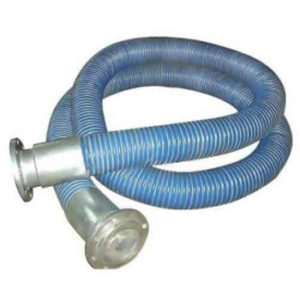
A composite hose is made from a combination of materials bound together in a single tube, unlike single-material hoses. It is based on the ‘mandrel-wrapped concept’ and consists of a wire spiral-wrapped around it with multi-layers of polymer (or other materials), followed by the second wire spiral. Composite hoses are durable & robust, simple to use, lightweight, and smoother than rubber hoses.
Even while an ordinary hose can crack or break under pressure or repeated use using single-layer material, a composite hose is a fail-safe product that will never experience aging or fatigue failure.
The composite hose may provide the critical versatile link in a fluid transfer system to compensate for vibration, movement, or misalignment.
The composite hose has an inner spiral metal supporting wire and has a spiral outer wire and usually is galvanized or stainless steel, aluminum, or polypropylene coated steel. Thermoplastic fabrics and film are layers between the wires.
Composite Hose Principle
Flexible composite hoses are used for the applications and industries mentioned below:
Applications
- Fuels & Oils
- Dry Chemicals
- Fluids
- Industrial Gases
Industries
- Petroleum & Gas Industries
- Chemical Industries
- Ship to shore
Basically, the different functions of the components are:
- The internal wire spiral protects the tube wall, which provides vacuum resistance for suction purposes.
- External wire winding shield the abrasion armor and damage it affects and securely binds the cloth layers and films.
- Fabric layers act against internal resistance as strength members. The exterior layer PVC-coated fabric is also a standard characteristic of many composite tubing. The color-coded surface is easy to purify and offers extra abrasion protection.
- In order to ensure that no product leaks from the nozzle, film layers serve as a sealing medium. Polypropylene, polyamide, PTFE, polyamide, or glass may be used in the films and textiles. Via a mixture of certain other materials, hoses with various chemical resistance, working conditions, and pressures can be generated in different ways.
- As for all types, the composite hose assembly relies on the strength and efficiency of its coupling device.
Composite Hose Vs Rubber Hose Comparison
- Composite hoses are 30 percent thinner than hoses made of plastic.
- The composite hose materials are fatigue-free and do not fail like rubber.
- The tiny particles of rubber will contaminate the fluid going through rubber hoses, while the inner coating is polypropylene cloth in the composite hose that would not contaminate the fluid.
- For multiple uses, the composite hose may be provided in different colors such that the hoses devoted to a certain application can be quickly recognized.
- On average, composite hoses have a longer life than rubber hoses.
- Throughout the life of the composite hose, electrical continuity is maintained.
Composite hoses are a very durable and longer-lasting alternative to hard rubber and petroleum and chemical transfer polyethylene hoses. Multiple tight-wound thermoplastic tubes and films are constructed from Composite Hose that create a permeation barrier. The proper pitch and gauge of the inner and outer wires are ensured by advanced MFG process techniques to ensure continuity and conformity at all times. The result is a completely versatile composite thermoplastic hose that does not collapse or kink with excellent service life and delivers exceptional efficiency and protection.


Leave a Reply